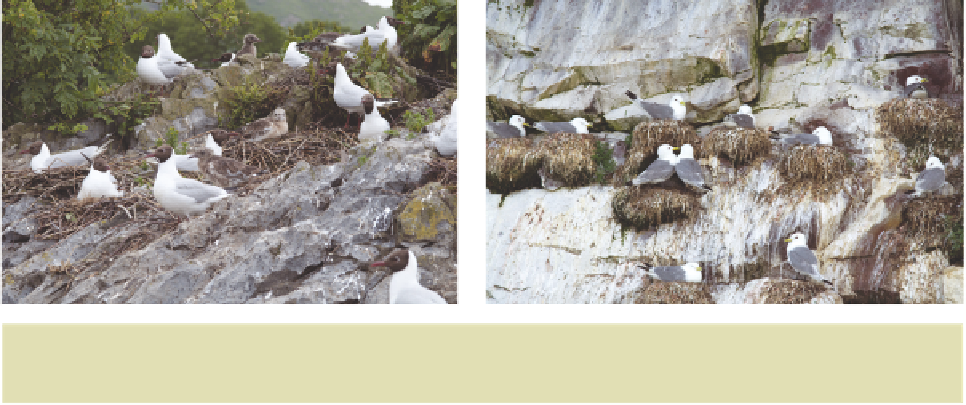Biology Reference
In-Depth Information
Breeding behaviour of gulls
in relation to predation risk
Most species of gulls nest on the ground, where their eggs and chicks are vulnerable to
predation by mammals (such as foxes and stoats) and by birds (such as crows and other
gulls). Many of the breeding traits of these ground nesters, such as the black-headed
gull (Fig. 2.1a), seem to make good sense as adaptations to reduce predation. For
example, the adults take flight whenever a predator approaches and they give alarms
and attack it. They maintain the camouflage of the nest by refraining from defecation
nearby and, soon after hatching, they remove the empty eggshells, which have white
interiors likely to attract predators. The chicks, like the eggs, are cryptically coloured;
they leave the nest soon after hatching and hide in the vegetation. This leads to some
mixing of neighbouring broods, so it makes sense that adults learn to recognize the calls
of their own chicks early on to ensure they direct their parental care to their own young.
Parents also give food calls to signal to their hidden young that food is available.
How might we test our hypothesis that these traits have evolved in response to
predation? Without testing, of course, our idea is no more than a plausible story. We will
see later in the chapter that the function of one of these traits, eggshell removal, can
easily be tested by experiment. However, other traits, such as chick behaviour or parental
food calling, cannot be so easily manipulated. It would be hard, for example, to
manipulate chicks so that they did not hide, or to manipulate parents so they did not call.
Esther Cullen, one of Niko Tinbergen's research students, showed that a comparison
with the breeding traits of a cliff-nesting gull, the kittiwake (Fig. 2.1b), provided comparative
support for the anti-predator hypothesis. Kittiwake nests are safer from mammalian
predators, who cannot so easily climb down steep cliffs, and they are also safer from avian
predators because the gusty winds around the cliffs make attacks from the air more difficult.
The different breeding traits of the kittiwake, compared to the black-headed gull, make
A suite of
adaptations to
reduce predation
Comparing a
ground-nester
with a cliff-nester
(a)
(b)
Fig. 2.1
(a) The black-headed gull nests on the ground. Photo © osf.co.uk. All rights reserved. (b) The kittiwake
nests on tiny ledges on steep cliffs. Photo © iStockphoto.com/Liz Leyden.






























